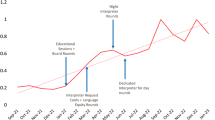ABSTRACT
BACKGROUND
Professional interpreter use improves the quality of care for patients with limited English proficiency (LEP), but little is known about interpreter use in the hospital.
OBJECTIVE
Evaluate interpreter use for clinical encounters in the hospital.
DESIGN
Cross-sectional.
PARTICIPANTS
Hospitalized Spanish and Chinese-speaking LEP patients.
MAIN MEASURES
Patient reported use of interpreters during hospitalization.
KEY RESULTS
Among 234 patients, 57% reported that any kind of interpreter was present with the physician at admission, 60% with physicians during hospitalization, and 37% with nurses since admission. The use of professional interpreters with physicians was infrequent overall (17% at admission and 14% since admission), but even less common for encounters with nurses (4%, p < 0.0001). Use of a family member, friend or other patient as interpreter was more common with physicians (28% at admission, 23% since admission) than with nurses (18%, p = 0.008). Few patients reported that physicians spoke their language well (19% at admission, 12% since admission) and even fewer reported that nurses spoke their language well (6%, p = 0.0001). Patients were more likely to report that they either “got by” without an interpreter or were barely spoken to at all with nurses (38%) than with physicians at admission (14%) or since admission (15%, p < 0.0001).
CONCLUSIONS
Interpreter use varied by type of clinical contact, but was overall more common with physicians than with nurses. Professional interpreters were rarely used. With physicians, use of ad hoc interpreters such as family or friends was most common; with nurses, patients often reported, “getting by” without an interpreter or barely speaking at all.

Similar content being viewed by others
References
Baker DW, Hayes R, Fortier JP. Interpreter use and satisfaction with interpersonal aspects of care for Spanish-speaking patients. Med Care. 1998;36:1461–70.
Jacobs EA, Lauderdale DS, Meltzer D, Shorey JM, Levinson W, Thisted RA. Impact of interpreter services on delivery of health care to limited-English-proficient patients. J Gen Intern Med. 2001;16:468–74.
Karliner LS, Jacobs EA, Chen AH, Mutha S. Do professional interpreters improve clinical care for patients with limited English proficiency? A systematic review of the literature. Health Serv Res. 2007;42:727–54.
Chen A, Youdelman MK, Brooks J. The Legal Framework for Language Access in Healthcare Settings: Title VI and Beyond. J Gen Intern Med. 2007;22:362–7.
Perkins J. Ensuring Linguistic Access in Health Care Settings: An Overview of Current Legal Rights and Responsibilities: Kaiser Commission of Medicaid and the Uninsured; 2003.
National Standards for Culturally and Linguistically Appropriate Services in Health Care: U.S. Department of Health and Human Services, Office of Minority Health; 2001.
Wilson-Stronks A, Galvez, E. Hospitals, Language and Culture: A Snapshot of the Nation. Exploring Cultural and Linguistic Services in the Nations Hospitals: A Report of Findings: The Joint Commission and The California Endowment; 2007.
Baker DW, Parker RM, Williams MV, Coates WC, Pitkin K. Use and effectiveness of interpreters in an emergency department. Jama. 1996;275:783–8.
Flores G, Torres S, Holmes LJ, Salas-Lopez D, Youdelman MK, Tomany-Korman SC. Access to hospital interpreter services for limited English proficient patients in new jersey: a statewide evaluation. J Health Care Poor Underserved. 2008;19:391–415.
Lee KC, Winickoff JP, Kim MK, et al. Resident physicians' use of professional and nonprofessional interpreters: a national survey. Jama. 2006;296:1050–3.
Diamond LC, Schenker Y, Curry L, Bradley EH, Fernandez A. Getting by: underuse of interpreters by resident physicians. J Gen Intern Med. 2009;24:256–62.
Burbano O'Leary SC, Federico S, Hampers LC. The truth about language barriers: one residency program's experience. Pediatrics. 2003;111:e569–73.
Schenker Y, Lo B, Ettinger KM, Fernandez A. Navigating language barriers under difficult circumstances. Ann Intern Med. 2008;149:264–9.
Brodaty H, Low LF, Gibson L, Burns K. What is the best dementia screening instrument for general practitioners to use? Am J Geriatr Psychiatry. 2006;14:391–400.
Karliner LS, Napoles-Springer AM, Schillinger D, Bibbins-Domingo K, Perez-Stable EJ. Identification of limited English proficient patients in clinical care. J Gen Intern Med. 2008;23:1555–60.
Sangha O, Stucki G, Liang MH, Fossel AH, Katz JN. The Self-Administered Comorbidity Questionnaire: a new method to assess comorbidity for clinical and health services research. Arthritis Rheum. 2003;49:156–63.
Kuo DZ, O'Connor KG, Flores G, Minkovitz CS. Pediatricians' use of language services for families with limited English proficiency. Pediatrics. 2007;119:e920–7.
Cohen AL, Rivara F, Marcuse EK, McPhillips H, Davis R. Are language barriers associated with serious medical events in hospitalized pediatric patients? Pediatrics. 2005;116:575–9.
Schyve P. Language differences as a barrier to quality and safety in health care: The joint commission perspective. J Gen Intern Med. 2007;22:360–1.
Karliner LS, Mutha S. Achieving quality in health care through language access services: lessons from a California public hospital. Am J Med Qual 2010 Jan-Feb; 25:51–9.
Divi C, Koss RG, Schmaltz SP, Loeb JM. Language proficiency and adverse events in US hospitals: a pilot study. Int J Qual Health Care. 2007;19:60–7.
Karliner LS, Kim SE, Meltzer DO, Auerbach AD. Influence of language barriers on outcomes of hospital care for general medicine inpatients. J Hosp Med 2010 May-June; 5:276–82.
Acknowledgements
This study was supported by grant no. 20061003 from The California Endowment and by grant no. P30-AG15272 of the Resource Centers for Minority Aging Research program funded by the National Institute on Aging, National Institutes of Health. Dr. Schenker was supported by the General Internal Medicine Fellowship at UCSF, funded by the Department of Health and Human Services, Health Resources and Services Administration (DHHS HRSA D55HP05165), and then by a Junior Faculty Career Development Award from the National Palliative Care Research Center. We thank Steven Gregorich for statistical advice, Gabriel Somma, Monica Lopez and Julissa Saavedra for data collection and management, and the staff and physicians at the Alameda County Medical Center for their participation.
Conflict of Interest
None disclosed.
Author information
Authors and Affiliations
Corresponding author
Rights and permissions
About this article
Cite this article
Schenker, Y., Pérez-Stable, E.J., Nickleach, D. et al. Patterns of Interpreter Use for Hospitalized Patients with Limited English Proficiency. J GEN INTERN MED 26, 712–717 (2011). https://doi.org/10.1007/s11606-010-1619-z
Received:
Revised:
Accepted:
Published:
Issue Date:
DOI: https://doi.org/10.1007/s11606-010-1619-z



